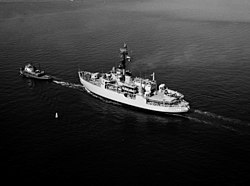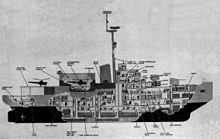USS Glacier (AGB-4)
|
The Glacier 1955
|
||||||||||||||||
|
||||||||||||||||
|
||||||||||||||||
|
||||||||||||||||
|
||||||||||||||||
The USS Glacier (AGB-4) (later USCGC Glacier (WAG / WAGB-4) was) an icebreaker of the United States Navy , later, the United States Coast Guard , who at first 15 expeditions of Operation Deep Freeze in Antarctica was used . The Glacier was the first icebreaker that made its way through the frozen Bellingshausen Sea and many geographical points there are named after the crew members of the ship. At the time of its construction, the Glacier was the ship with the most powerful DC motors installed. The Glacier was able to break ice thicknesses of up to 6.1 m and penetrate ice of up to 1.20 m in continuous travel at 3 kn (5.6 km / h).
Named after Glacier Bay in Alaska , the Glacier was acquired by Ingalls Shipbuilding Corp. on August 27, 1954 . Commissioned in Pascagoula , Mississippi . She was baptized by Roscoe F. Good. It was launched on May 27, 1955 under Commander EH Mayer. The Glacier remained a single ship . She was in the US Navy for eleven years and then with the US Coast Guard for 21 years.
construction
The Glacier was essentially an improved version of the wind-class icebreaker , essentially larger and more powerfully constructed. As a result, it was characterized by an outer shell designed for strength. Their length was small in relation to the strength of the drive. The bow had the slope typical of an icebreaker, which enabled it to hit the ice and break due to the weight of the ship. The stern was designed analogously to enable backwards maneuvers in the ice. The sides of the fuselage were rounded and tapered again significantly towards the top. This made it possible for the ship to free itself from the ice by heeling to the side or by changing the trim forwards and backwards. A diesel-electric drive was chosen because of its better controllability and higher mechanical insensitivity.
history
Operations in Antarctica (1955-1960)
The maiden voyage of the Glacier took place as the flagship of Rear Admiral Richard E. Byrd as commander of Operation "Deep Freeze I". In December 1955 it encountered ice for the first time on the northern edge of the Ross Ice Shelf and broke into an ice port in Kainan Bay , where the components for the Little America V base were subsequently unloaded. The Glacier advanced another 400 nm to the west in order to pave the way for a further unloading point for the establishment of the "US Naval Air Facility" in McMurdo Sound .
In March 1956, the Glacier explored the Weddell Sea . It measured Vincennes Bay in Wilkesland and enabled the first landing on the Princess Martha and Princess Astrid coasts . Then the Glacier returned to her home port of Boston , which she reached on May 6, 1956.
The ship returned to McMurdo Sound on October 28, 1956 as part of Operation Deep Freeze II. At this point in time, this was the earliest advance of a ship into the sound of the season. The Glacier brought material and supplies to McMurdo Station and Little America, with seven other ships of the Royal New Zealand Navy (RNZN) led through the pack ice to the two stations. In January 1957 she brought two barges into Vincennes Bay, where the last of the seven American bases for International Geophysical Years was established. The Glacier left the new Wilkes Station after the operation was completed on February 17, 1957, destined for the United States via Melbourne .
During Operation “Deep Freeze III” in the International Geophysical Year, the Glacier served as a launch platform for “ Rockoon ” tests, which provided information for the Explorer program . In addition, she performed icebreaker and escort services and carried out an oceanographic survey of the Ross Sea .
In the summer of 1958, Glacier performed ice guiding services for supply trips to the Arctic radar and weather stations as part of "Operation Sunec" . From November 1958 she returned to McMurdo Sound for supply trips and supported the closure of the “Little America V” station. Afterwards, two previously unknown islands and the largest ever observed colony of emperor penguins with around 50,000 birds were discovered from board the Glacier while cruising in Terra Nova Bay on the coast of Victoria Land. The Glacier then hurried to support the Belgian expedition ship Polarhav under Gaston de Gerlache in Breidvika almost halfway around Antarctica.
For Operation “Deep Freeze V” 1959–1960, the Glacier drove again to McMurdo-Sund and to explore the Bellingshausen Sea . At the end of February 1960, she rushed to support General San Martín , an icebreaker for the Argentine Navy, and the Danish supply ship Kista Dan . After completing this rescue mission, the Glacier drove into Rio de Janeiro on April 2, 1960 to provide rescue services in flooded areas for twelve days. She also did this in a subsequent rescue mission in Paramaribo , Suriname . She reached Boston again on April 17, 1960.
Operations in Antarctica (1960–1966)
On October 13, 1960, the Glacier left Boston for her sixth Antarctic voyage. It stopped in Lyttelton on November 21, 1960 to shop. Throughout December, it continuously kept a 40 km long canal through McMurdo Sound open for supply ships. She then returned to New Zealand ( Wellington ) for necessary repairs and the award of a US Navy Unit Commendation for the expedition to the Bellingshausen Sea. She then returned to Antarctica for further exploration in the Amundsen and Bellingshausen Seas. The oceanographic work lasted until March. She reached her home port in Boston on April 27, 1961.
As part of the participation in Operation "Deep Freeze 62" from October 8, 1962, she landed again in Lyttelton in early November. The Glacier reached the pack ice in the Ross Sea on November 13, 1961 and McMurdo Sound at the end of the month. After repairs in Wellington, she returned to McMurdo Station and the location of Little America V Station for mapping work. She returned to New Zealand on March 6, 1962. After traveling more than 60,000 km, she reached Boston on May 5, 1962.
The Glacier ran out on September 17, 1962 for Operation "Deep Freeze 63", reached the pack ice on November 6, 1962 and the end of the shelf ice on McMurdo Sound a week later. After a minor damage in thick pack ice, she drove on to Wellington for repairs and then paved the way to McMurdo station again on December 31st.
The Glacier also performed crusher services on the route to the McMurdo station in the following years. On December 29, 1965, she pushed an iceberg out of the fairway together with the US icebreakers Atka and Burton Island . After her eleventh participation in operations "Deep Freeze", she returned to Boston in spring 1966, where she was removed from the Navy's list of ships on July 1, 1966 and handed over to the US Coast Guard the day after.
Coast Guard (1966-1987)
The heavier armament of the Glacier had been removed before it was handed over to the Coast Guard . In 1968 the 5-in twin rifles were also removed, only the Browning M2 and M60 machine guns remained as law enforcement tools. In 1973 the ship and helicopter were painted red to increase visibility in the ice.
In 1975 the Glacier was trapped in the ice of the Antarctic for six days. In the end, she managed to escape into the open waters of Antarctic Sound . The coast guard of their home port Long Beach reported that they could only operate with one propeller because two of the three blades of the second propeller had been sheared off on March 5, 1975 in "steel hard ice". The Glacier had been on an aid mission for the Argentine icebreaker General San Martin , who had engine problems during a supply trip, but was able to free himself in the end.
Decommissioning
After 29 trips to the Antarctic and another 10 to the Arctic, the Glacier was taken out of service in 1987. It became the responsibility of the United States Maritime Administration (MARAD) and was launched in the US Naval Reserve Fleet in Suisun Bay on the Sacramento River . The "Glacier Society" saved the ship from scrapping in 2000 and planned to convert the ship into a hospital or research ship. Nevertheless, the Glacier was sold to ESCO Marine in Brownsville for recycling on February 16, 2012 for US $ 146,726 . Further rescue efforts were made and the ship was brought to the former Mare Island naval base in Vallejo on April 17, 2012 for cleaning. In June, the ship was nevertheless moved to Brownsville and MARAD cleared the scrapping beginning on July 2, 2012.
Directions to the harbor in Winter Quarters Bay , McMurdo Station
Awards
Web links
- History of the USS Glacier (AGB-4) in the Dictionary of American Naval Fighting Ships (English)
- USS Glacier Association
- American Society of Mechanical Engineers - USS Glacier
- The Glacier Society
Footnotes
- ↑ John E. Moore (Ed.): Janes Fighting Ships 1979-80. Janes Yearbooks, London 1979, ISBN 0-354-00587-1 .
- ^ USCG Glacier . In: US Coast Guard History Program . United States Coast Guard . Retrieved December 17, 2012.
- ↑ USCG Icebreakers . In: US Coast Guard Cutter History . United States Coast Guard. Retrieved December 12, 2012.
- ↑ NHHC, Dates in American Naval History. https://www.history.navy.mil/research/histories/ship-histories/danfs/g/glacier-iv.html
- ↑ United Press International: Icebreaker Gets Away From Ice. In: Playground Daily News. Fort Walton Beach, Florida, Wednesday March 12, 1975, Volume 30, Number 29, p. 8B.
- ↑ Information from the sales contract.
- ↑ US senators move to save old ice breaker from scrap yard ( Memento of the original from April 19, 2012 in the Internet Archive ) Info: The archive link was inserted automatically and has not yet been checked. Please check the original and archive link according to the instructions and then remove this notice. . JuneauEmpire.com, April 17, 2012
- ↑ Medals and Awards Manual, Homeland Security, p. 266 pdf file







